Zine :
Lien original : Hammer&Hope
En français :
Inspired by a need for more grounded, non-elite analyses of the current situation in Sudan, we interviewed four people whose organizing against the oppressive policies of the Sudanese state spans years and in some cases decades. Each of them links the revolution to the current war and foreground the organizing and collective visioning processes that have and could potentially still move us toward a popular democratic future in a post-war Sudan. We are incredibly grateful to them for speaking to us despite the circumstances that they face, including telecommunications and electricity blackouts in much of the country. In this first installment, you’ll read our introduction and an interview with Abdelraouf Omer, a Gezira farmer and union organizer.
If you would like to help grassroots civil society and mutual aid groups at the frontlines of relief efforts in parts of Sudan most impacted by state violence, donate to the Sudan Solidarity Collective.
— Rabab Elnaiem, Nisrin Elamin, and Sara Abbas
It is now 15 months into the war in Sudan between the Sudanese Armed Forces (SAF) and the Rapid Support Forces (RSF) militia. Yet the media attention Sudan receives does not reflect the monumental crisis it is facing and that threatens the broader region. When the mainstream media does cover Sudan, it tends to focus exclusively on the humanitarian catastrophe that the conflict has produced, which began on April 15, 2023, following the RSF and SAF’s joint Oct. 2021 coup. By contrast, grassroots organizers in Sudan tend to highlight the processes of marginalization, extraction, and militarization that make such a crisis productive for those in power.
The humanitarian reality is so devastating that the United Nations has described the suffering as “epic,” declaring Sudan “a nightmare for civilians.” International diplomacy and corporate extraction made this nightmare possible by legitimizing and keeping Sudan’s coup leaders in power, paving the way for this war. The unwillingness of the UN and the African Union, along with powerful entities such as the U.S. and European Union governments, to effectively leverage their power to stop the flow of arms and achieve a cease-fire is the latest example of why we cannot expect any kind of positive intervention from the state system and multinational institutions. Without a cease-fire, establishing safe passages and humanitarian corridors has proved elusive, as has stopping the targeting of civilians, first responders, journalists, homes, and remaining health and other critical infrastructure in an ever-expanding circle of bombings, burnings, sexual violence, and plunder. The suffering is epic because the world’s ethical and material failure to provide relief for those inside Sudan and fleeing across its borders has also been epic.
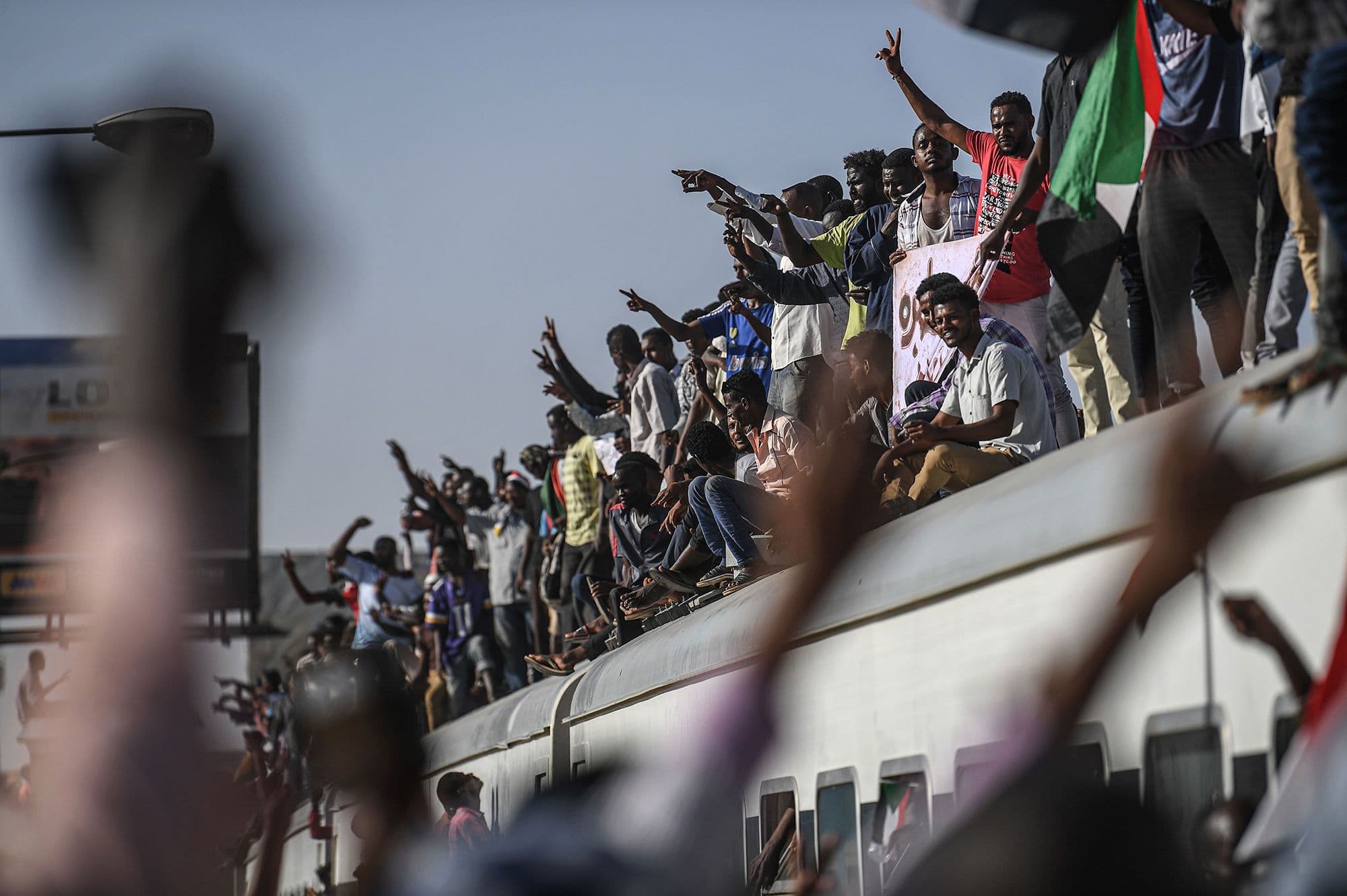
Sudanese protesters from Atbara make “V for victory” gestures as their train arrives in Khartoum, April 23, 2019. One of the earliest protests against ousted president Omar al-Bashir had erupted in Atbara in mid-December 2018. Photograph by Ozan Kose/Agence France-Presse, via Getty Images.
With every month, the catastrophe reaches new depths. The need for urgent attention and an immediate response remains. Yet thinking of humanitarianism alone masks the root causes of the violence, which are shaped by colonialism and racial capitalism. The desire to finally confront these historical forces gave rise to Sudan’s December Revolution in 2018, propelling the country into one of the most powerful movements for emancipation in the 21st century. The exclusion of the December Revolution and its demands, encapsulated in its slogan “Freedom, peace and justice,” from political discussions is not just a theoretical failing — it has had an effect on the ground, undermining people’s ability to exercise their agency to help themselves.
From Humanitarian Disaster to Proxy War
The humanitarian catastrophe in Sudan has produced calamitous figures. More than 10 million people have been displaced over the past year (including most of our families), with three million people crossing the border in increasingly desperate attempts to find refuge. Despite persistent warnings that famine is already underway, threatening more than 25 million people, less than 20 percent of the aid requested by the UN has been received. Looting, electricity outages and targeted attacks on farmers by the RSF has disrupted the planting season. The RSF has continued ethnic cleansing campaigns targeting the Masalit and other non-Arab groups in Darfur. In Darfur, Khartoum, and other areas of active fighting, sexual violence against women and girls is widespread and unaddressed. Across the country, 19 million children have lost access to education as state institutions collapse and defunct schools turn into shelters. As we write, El Fasher, capital of North Darfur and one of the country’s largest cities, is under a siege of bombardment and starvation not unlike Gaza’s. The dismal response by the so-called international community has been shameful and is shaped by anti-Black racism.
To be clear, the war is not purely an internal power struggle nor simply a proxy war of regional or “super” powers but a multi-scalar counterrevolutionary war supported by internal and external actors linked by capital and the desire to preserve the violent, extractive, ethno-nationalist, postcolonial Sudanese state. Western powers invite elite civilian actors, such as Taqaddum, to closed-door meetings at which they are asked to represent Sudanese civilians, where the focus is how to reach another agreement with the military and militias and to restore governance. The revolutionaries we are in touch with see the primary purpose of this war as overshadowing people-led visions and processes that were developed during the revolution.
The December Revolution
To understand the war primarily through the lens of counterrevolution, it is important to situate it in Sudan’s recent political history, starting in 1989. That year the National Islamic Front, a political organization with distant roots in the Muslim Brotherhood, took power through a military coup d’état, establishing the regime headed by Omar al-Bashir and known in Sudan as the Inqaz, or Salvation, regime. It endured for nearly three decades, a period that saw an intensification of state violence against non-Arab communities in South Sudan, the Nuba Mountains, the Blue Nile region, and, starting in 2003, Darfur, Sudan’s westernmost region. Just as a peace agreement was being negotiated to end the war in the south, paving the way for South Sudan’s independence, a genocidal war began in Darfur. With quelling the rebellion as a rationale, the regime unleashed the Janjaweed militias from pastoralist Arab groups in the region in a genocidal campaign against non-Arab communities. The result was the burning of thousands of villages, the displacement of millions, and the killing of hundreds of thousands.
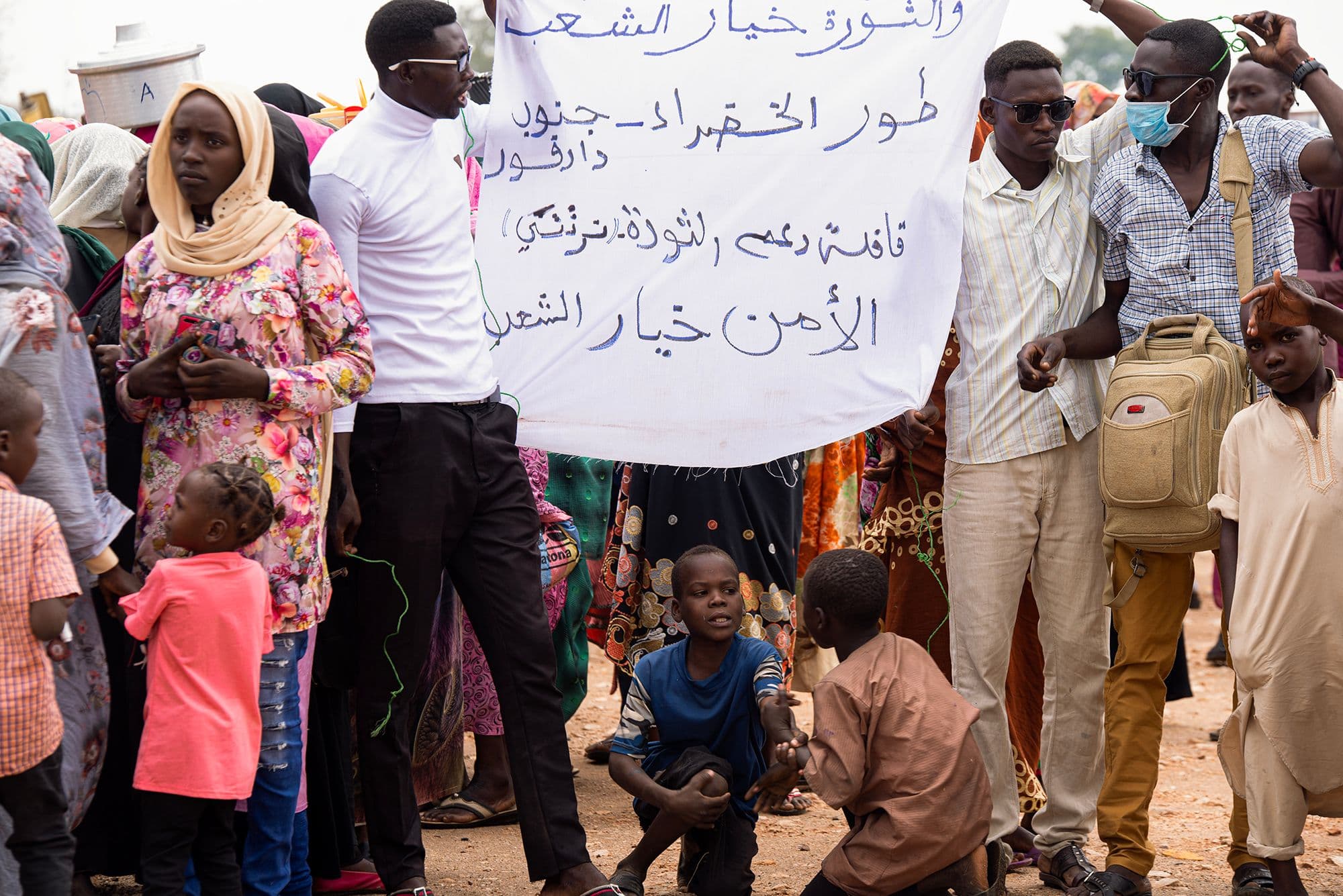
Protesters hold a banner reading “The revolution is the choice of the people / [Town of] Thure, Al Khadraa, South Darfur / A caravan procession in support of the revolution / Security is the choice of the people,” Darfur, Dec. 2, 2020. Photograph by Faiz Abubakr.
Three decades of Salvation rule shifted the economy from its colonial basis of cash crops like cotton grown in large, centrally managed irrigation schemes to the production and export of crude oil. Below Abdelraouf Omer makes clear the devastating effect state policies had on rural livelihoods, including in his state, Gezira, a region in the so-called Arab heartland of Sudan, just a stone’s throw from Khartoum. Rents from oil and other sources became increasingly concentrated in the hands of the regime and its external clients, primarily but not exclusively Arab Gulf states. State institutions were purged of any opposition and populated with regime loyalists in a policy the regime called “Empowerment” (“Tamkeen”).
After independence, there were two major civic uprisings prior to 2018, in 1964 and 1985. Each brought down a military regime, only for the military to stage a coup d’état that returned it to power a few years later. War, genocidal campaigns, structural racism, repression of women and dissidents fueled grievances on a massive scale, as did mass unemployment facilitated by neoliberal privatization policies, land dispossession, and economic collapse. Resistance to the Salvation regime took many forms, both armed and unarmed, after 1989. Small civic uprisings in 2013 and 2016, triggered by austerity measures and price hikes after Sudan lost access to oil in South Sudan after its independence, were suppressed efficiently and brutally. But a key organizing tool, resistance committees, emerged from those so-called failed uprisings.
In December 2018, protests over the exorbitant price of bread grew to include a whole host of social grievances and attracted broad segments of the population. What became known as the December Revolution coalesced into a unified demand for the fall not just of al-Bashir and his ruling party but of the military state as a whole. The core demand of the revolutionary movement became madaniya: full civilian rule, with the military removed from politics and the economy.
In April 2019, popular pressure forced the fall of al-Bashir and his ruling National Congress Party. In a bid to stabilize and maintain the military state, senior military officials formed a transitional military council that also included the RSF, a militia that al-Bashir had formed from the remnants of the Janjaweed militias. Negotiations with civilian political groups resulted in a power-sharing agreement between technocrats and opposition politicians and the military. The idea was that the military would eventually step away from power, and elections would be held for a fully civilian government.
This “transition” began in August 2019 and ended with the October 2021 coup by SAF and RSF, who were still allies. The elite civilian members of the transitional government had adopted neoliberal reforms rather than respond to the demands from the streets. One example is the normalization of relations with Israel called the Abraham Accords, which the transitional government signed in January 2021 in exchange for being dropped from the U.S. list of state sponsors of terrorism and the promise of a $1 billion loan to clear its debt with the World Bank despite opposition from resistance committees and the public. The months that followed the coup saw frenetic attempts by the SAF to consolidate power countered by continued resistance to the military. At the same time, the revolutionary project accelerated, which saw intense work locally and nationally to build structures capable of developing a people’s vision of power. In 2022, resistance committees signed the Revolutionary Charter for Establishing People’s Power, a political document developed through a collective visioning process that maps out a popular democratic future from the bottom up.
After the coup, tensions between SAF and RSF grew, including over control of Sudan’s gold. After the loss of oil revenues with South Sudan’s independence in 2011, gold replaced oil as the biggest source of revenue for the regime. Sudan quickly became one of Africa’s biggest exporters of gold; up to 90 percent of that gold is smuggled out of the country. Most gold mines and distribution networks belong to the RSF or the military and other remnants of the Salvation regime. The main destination for the looted gold is the UAE; from there, it enters global markets. Russia and other countries have been stockpiling Sudanese gold. In return for gold, the UAE has been supplying the RSF with weapons that are smuggled into Sudan via Chad and Libya.
With a war that is first and foremost a product of the counterrevolution, the question becomes not when peace will come but what sort of peace. Will it be a peace based on power sharing between military and civilian elites, which will only temporarily halt the violence, or a true peace built on justice and a new bottom-up governance model that breaks with the past and dismantles existing systems of elite power and systematic appropriation? Despite this brutal war, millions of Sudanese people still insist, per a popular chant, “The revolution is the people’s revolution. The authority is the authority of the people. The military belongs to the barracks, and the Janjaweed is to be dissolved.”
You can find a detailed timeline of Sudan’s recent history of revolution and counterrevolution here.
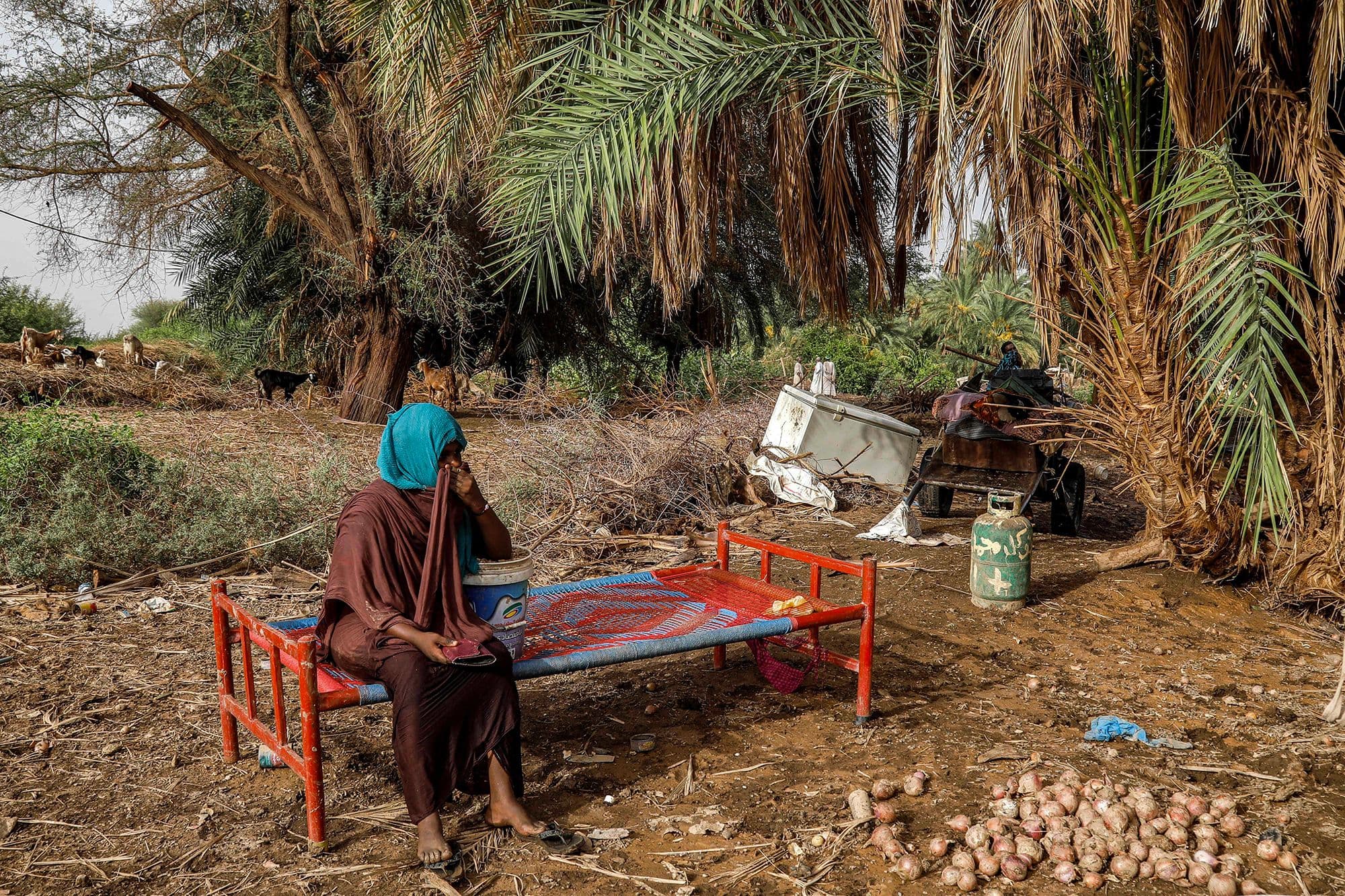
A woman sits on a salvaged bed in an area devastated by floods in northern Sudan, Aug. 6, 2023. Photograph by Agence France-Presse, via Getty Images.
Land Justice and the December Revolution
Abdelraouf Omer is a farmer and union organizer based in the town of Hassaheissa, in the agricultural Gezira region of central Sudan. He is a Middle East and North Africa representative of La Via Campesina, an international peasant movement dedicated to defending food sovereignty and farmers’ rights. He is also a scholar focusing on the impact of the privatization policies of the Salvation regime on rural livelihoods and on the history of peasant and farmworker organizing. His latest research focuses on water waste in Sudan’s agricultural sector and the Grand Ethiopian Renaissance Dam. He has been organizing, as part of the Coalition of Gezira and Managil Farmers, against the al-Bashir regime’s privatization of the Gezira scheme. Until the early 2000s, the scheme was one of the largest state-run irrigation projects in the world, relying on the labor of small landholding farmers and agricultural workers. Here he discusses the December Revolution and the current war, foregrounding state-sponsored land expropriation as key to understanding the counterrevolutionary violence engulfing the country.
I was born in the village of Faris Al Kitab to a family of wheat and cotton farmers in the heart of the Gezira irrigation scheme and acquired my farming skills at a very young age. Faris Al Kitab is known for its history of socialist organizing against colonial and postcolonial regimes since the 1940s. My father’s house was a gathering place for farmers to discuss their concerns vis-à-vis the state administrators of the scheme, because he held a role within it, representing their concerns. So I grew up surrounded by activism and by people airing their grievances against their employers and the state. I left Faris Al Kitab in the 1980s to become a teacher, first in Wadi Shaeer and then in Hassaheissa, where I joined the Communist Party and helped establish a teachers’ union that worked with other labor formations to reclaim power from the state-led Sudanese Socialist Union, which served the interests of the Nimeiri regime [1969–85].
The December Revolution emerged in response to the accumulated impact of 30 years of the Salvation regime’s policies and arguably the decades of capitalist extractive policies that preceded it. Some of these policies, driven and recommended by the IMF, World Bank, and WTO, focused on liberalizing the economy and privatizing the public sector. As a result, massive unemployment among workers, the professional class, and recent graduates became widespread. People suffered rampant poverty and hunger. A vast majority of Sudan’s wealth was concentrated in the hands of a small portion of the population, many of whom belonged to the ruling Islamist party. Through massive corruption, these elites managed to get hold of all the economic projects and production sites across Sudan, which they emptied of qualified staff. Positions in both the shrinking public sector and the expanding private sector were taken over by unqualified employees who belonged to the ruling party. This is how they gained control of most of the economy: companies, banks, factories, associations, etc. In the Gezira and other farming areas, the former regime targeted agricultural schemes and subsistence projects through privatization policies and restructured the workforce — as they did in the industrial and service sectors — in such a way that it lost important centers for organizing.
To manage and suppress the discontent that was produced through these policies, the regime fortified and expanded the security apparatus of the state, creating special security forces and opening torture houses and prisons, all of which were used to criminalize and suppress dissent under the ideological guise of political Islam. As the security state expanded in Sudan’s center, state violence escalated in the country’s marginalized regions of Darfur, the Southern Blue Nile region, and the Nuba Mountains. The state armed militias to suppress different forms of popular and armed resistance. In Darfur, this led to what is now known as a genocide against non-Arab communities. The state displaced millions of non-Arab Darfurian farmers in order to exploit the region’s gold and uranium. The international community intervened primarily to provide shelter and aid to displaced Darfurians, which ultimately cost less than the mineral wealth extracted by companies working with regime leaders. The current war is duplicating a similar process of violent extraction and is spreading it to other parts of the country.
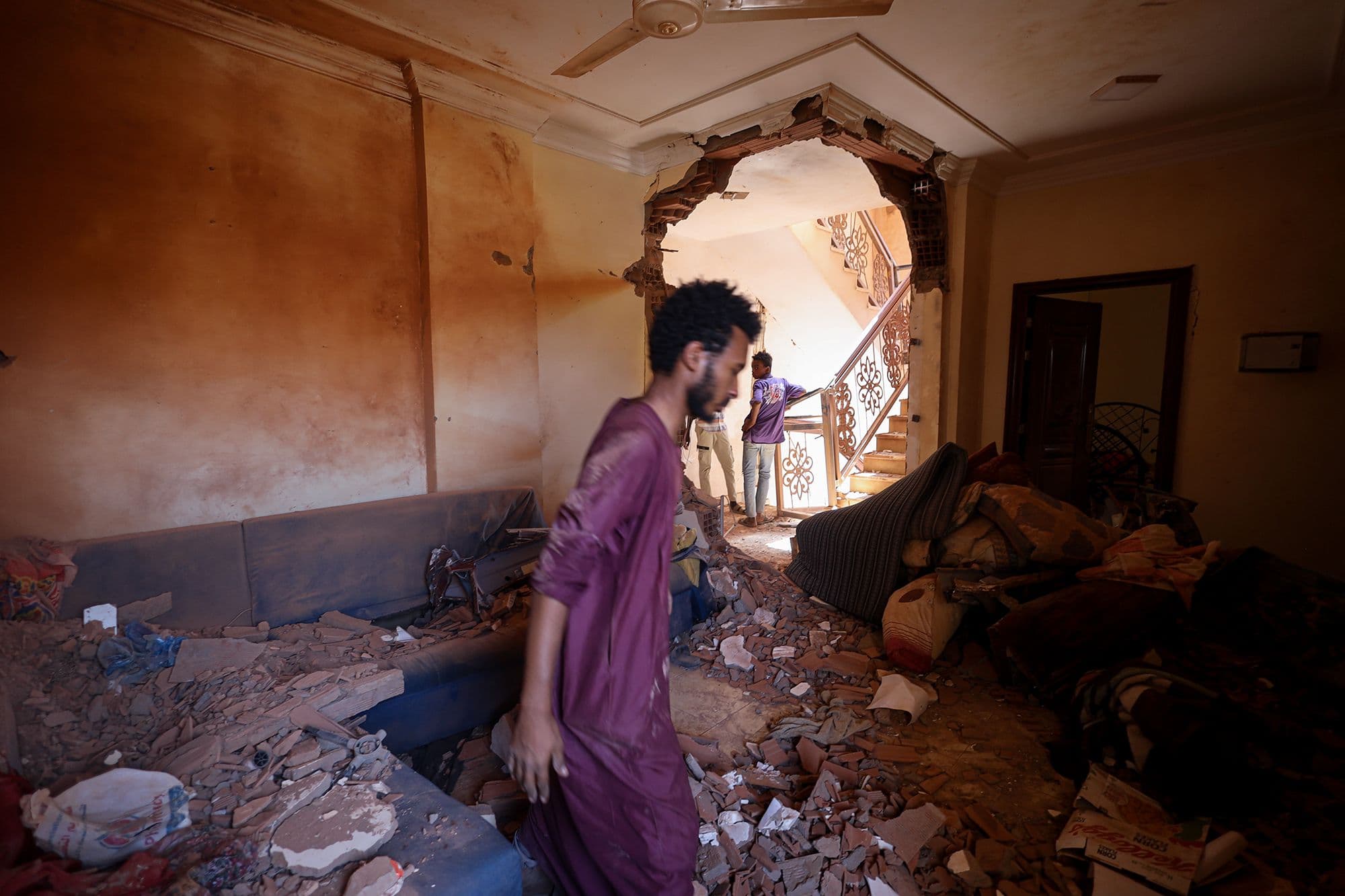
A man walks through a house in Khartoum that was shelled during the war that broke out between the Sudanese Armed Forces and the Rapid Support Force, May 2023. Photograph by Faiz Abubakr.
This is the context in which the December Revolution emerged. A deepening economic crisis converged with the expansion and intensification of state violence in Sudan’s marginalized regions. This convergence gave rise to new forms of organized resistance and civil disobedience that attracted the masses. Drawing on their historical legacy of resistance to state elites, from the Mahdist Revolution of 1885 to the October Revolution of 1964 and the intifada of 1985, Sudanese people began to engage in various forms of protest in the 2010s, which eventually reached the capital in 2013. New strategies and tools of resistance emerged, paving the way for the revolution. These included not only protests and marches but also building public democratic organizations that aimed to regain the power that elites had taken from the people. It was then that the resistance committees were formed, accelerating a movement that had begun in rural areas and spread to Sudan’s cities, culminating in a massive sit-in in the capital, Khartoum. On April 11, 2019, the 113th day of the revolution, this movement overthrew Omar al-Bashir after 30 years in power. Beyond this moment, the revolution represented the awakening of the Sudanese people from the IDP [internally displaced persons] camps in Darfur in the west to Al-Damazin and Khashm El Girba in the east and the cities of the Gezira and Khartoum in the center, which had never seen demonstrations in the millions or witnessed a broadening of political tactics to include sit-ins, processions, barricades, public strikes, and boycotts.
The goal of the revolution was to dismantle the old regime politically, economically, and legally. The April 15 war aims to stop this. It serves the interests of a parasitic capitalist elite linked to and scaffolded by regional and international processes of imperialism that have destroyed all the means of production. Since the beginning of this war, the country has lost myriad light-industry factories and blacksmith and carpentry workshops in Khartoum state and beyond. Scores of buses, petrol stations, as well as 14 central markets and 22,000 shops, have been looted or destroyed. This impacts over a million workers, in addition to the hundreds of thousands employed in the informal sector of the economy.
The current war is a counterrevolutionary political and class struggle for authority and resources driven by the interests of global capital. These forces don’t mind replacing a totalitarian system, already rejected by the people, with a fake civil and democratic government adopting a neoliberal system controlled by elites, who will continue to rob and exploit Sudan’s human and natural resources. Land is at the center of this struggle. By land I mean soil but also water, livestock, forests, minerals, oil, and other resources that local, regional, and international elites have sought to control and exploit since ancient times. Of course, during the Turco-Egyptian colonial period, Sudanese resources served the ruling class in Egypt. At independence from Anglo-Egyptian rule in 1956, we essentially exchanged an extractive colonial system for an extractive global capitalist system.
The Gezira Scheme Act of 2005 was an important turning point for us as members of the Coalition of Gezira and Managil Farmers. After coming to power in 1989, the Inqaz regime had liberalized the economy through privatization. It dissolved unions and farmer cooperatives, attacked civil society organizations, and created laws to restrict people’s freedom. The 2005 act accelerated this process, particularly the takeover of the Gezira irrigation scheme. It facilitated the privatization and sale of all the scheme’s productive inputs: its offices, ginning mills, companies such as the Sudanese cotton company, agricultural machinery, storage facilities, warehouses, workers’ houses and so on were sold to mainly domestic private investors. This allowed state elites to begin buying up the land of small farmers, who had fallen into debt due to the withdrawal of state extension services and the privatization of the scheme.
As a coalition we organized against this under the slogan “No to privatization and no to the sale of the Gezira scheme’s land.” We presented an alternative to the 2005 act that included the creation and strengthening of small-farmer cooperatives. We put forward candidates in the 2005 local elections who won despite rigging but whose victory — though protected by a court ruling — was later rejected by the Registrar of Labor Organizations. We took legal action against the sale of our lands and against the distribution of expired seeds by the Sudanese cotton company, which had been taken over by the ruling party. Through a collective process developed over the course of seven gatherings, we developed a Charter for Land Justice. The charter proposes alternatives not only to the 2005 act but to the 1927 and 1984 Gezira scheme land acts that preceded it. It also opposes a 2011 law that replaced existing trade unions with associations that were taken over by wealthy farmers and capitalists. This takeover destroyed the workshops responsible for the upkeep and management of the scheme, including its irrigation networks, and transferred these responsibilities to private companies, which began selling off tractors, trucks, and digging equipment. Many are now being used in gold mining in other parts of the country.
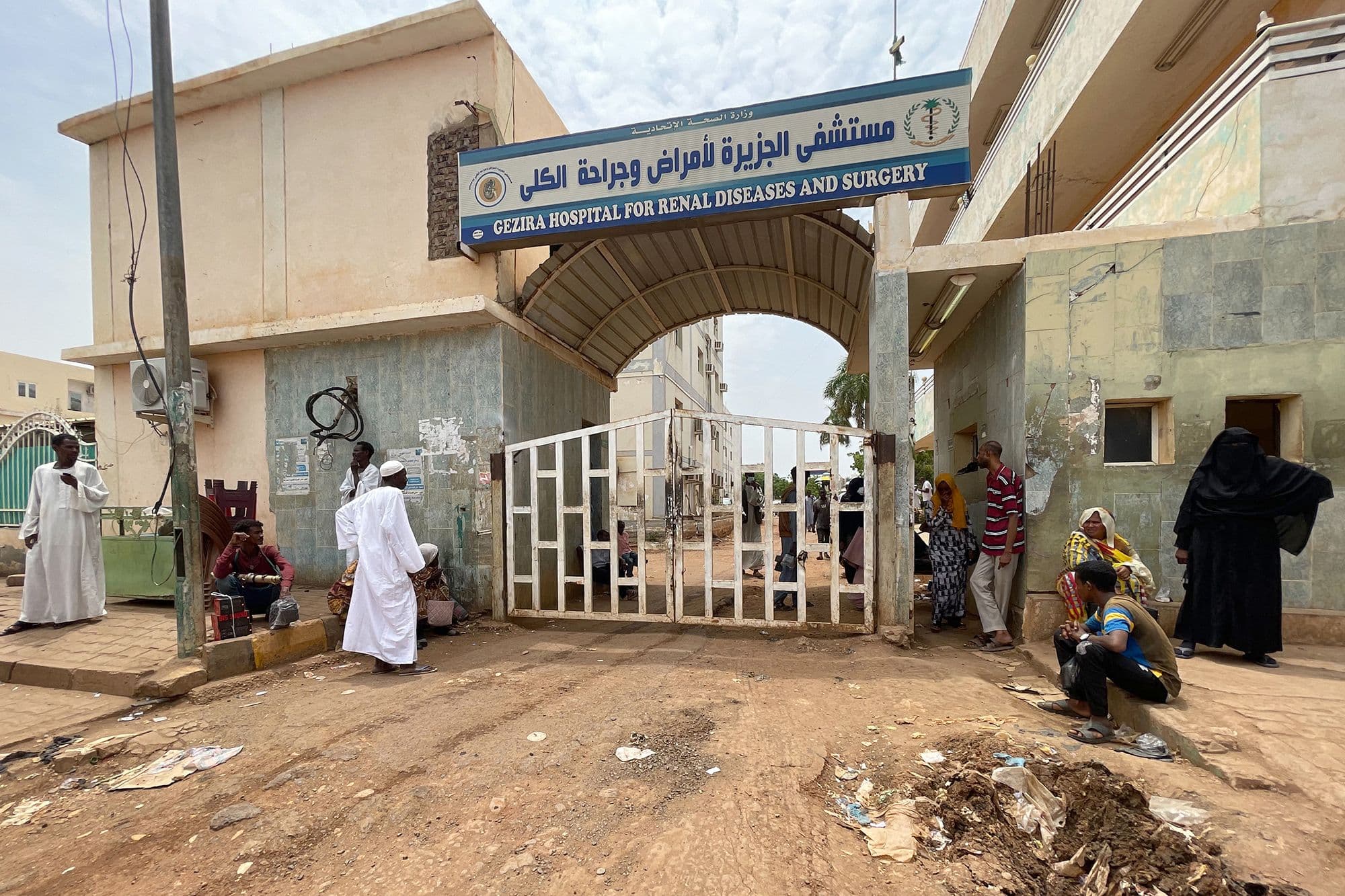
Patients wait for treatment at a hospital in Wad Madani, Sept. 2, 2023. Photograph by Agence France-Presse, via Getty Images.
As the coalition grew, we also developed a political education wing. We produced booklets on (1) the history of the farmers’ movement from the 1946 strike to the present; (2) the environmental harm caused by pesticides and fertilizers, which have led to some of the highest rates of cancer and kidney disease in the country; and (3) the dangers of the laws and agricultural policies implemented under the Inqaz regime. During the revolution, we continued organizing around these issues and participated in attempts to reclaim land and productive inputs stolen by the former regime. We met with representatives of the transitional government, including Prime Minister Hamdok and the governor of Gezira state, to share our concerns and to present the alternatives we proposed in our charter. They did not take us seriously, and attempts by local officials to implement our ideas were met with delay tactics. As a result, land dispossession continued during the transition period and the land being farmed by small farmers shrank.
Just recently, Gezira small farmers gathered to prepare for the planting season while affirming that there can be no planting without security. We cannot farm if it means we risk being killed and looted and violated by the RSF. The coalition estimates that around 70 percent of farmers have been displaced by this war, and the numbers are increasing every day. The Gezira, and the agricultural sector more broadly, are in our view the key to development in Sudan. We cannot afford to hand it over to the capitalists who are waging and profiting from this war.
Sara Abbas is a researcher of gender, the state, and social movements, with a focus on Sudan. Her publications include a contribution to Diversity on Common Ground: Ten Perspectives on Modern Feminism.
Nisrin Elamin is an assistant professor of African studies and anthropology at the University of Toronto and a member of the Sudan Solidarity Collective. She is writing a book on Gulf Arab capital accumulation and land dispossession in central Sudan.
Rabab Elnaiem is a Sudanese activist, labor organizer, and former spokesperson for the Sudanese Workers Alliance for the Restoration of Trade Unions (SWARTU) currently based in the United States. She is a co-founder of the Ta Marbuta podcast, a feminist, anti-capitalist podcast.
Abdelraouf Omer is a farmer, union organizer, and a Middle East and North Africa representative of La Via Campesina, a global peasant movement. He is based in the town of Hassaheissa, in Sudan’s agricultural Gezira region, but was recently displaced by the war.